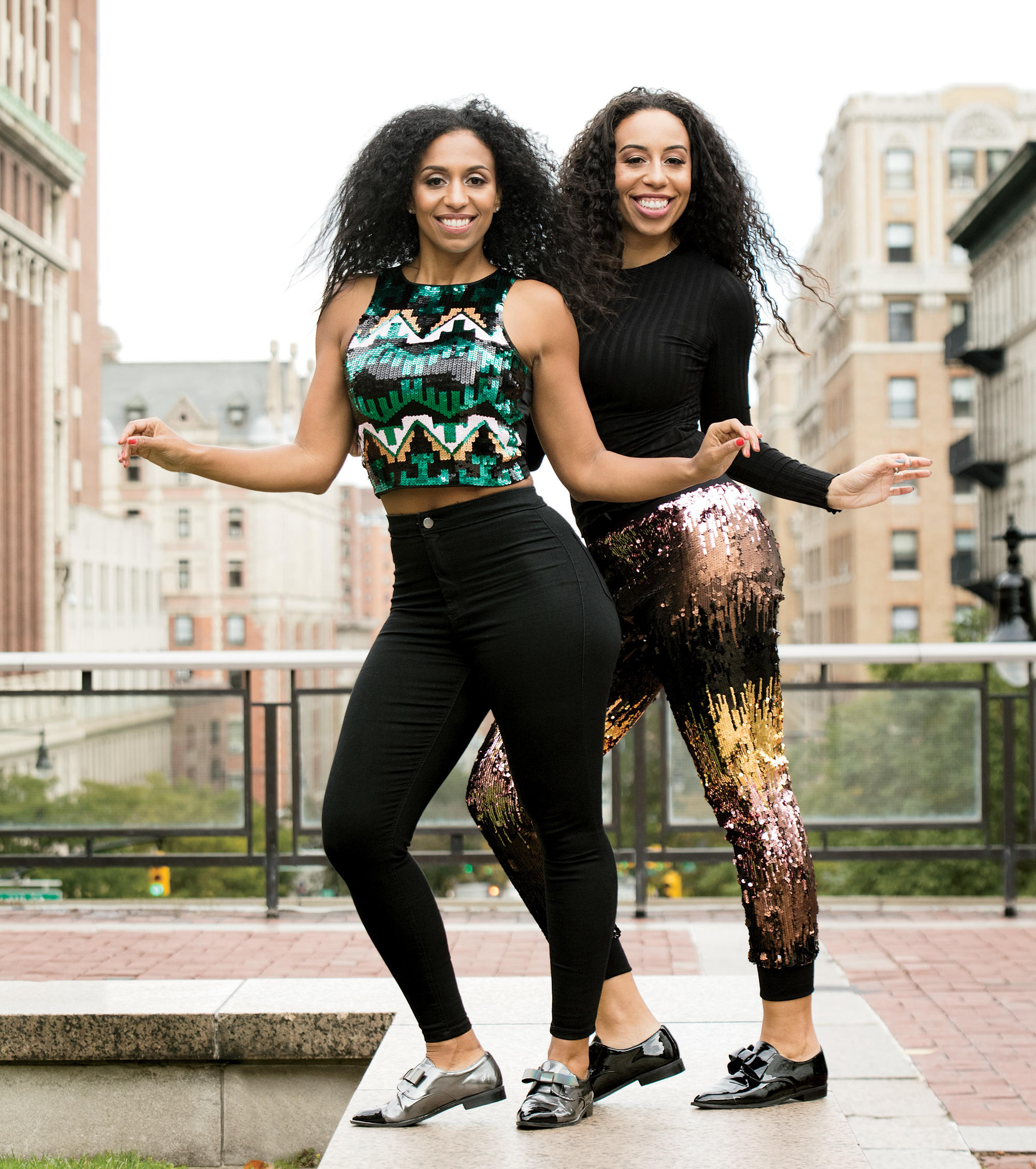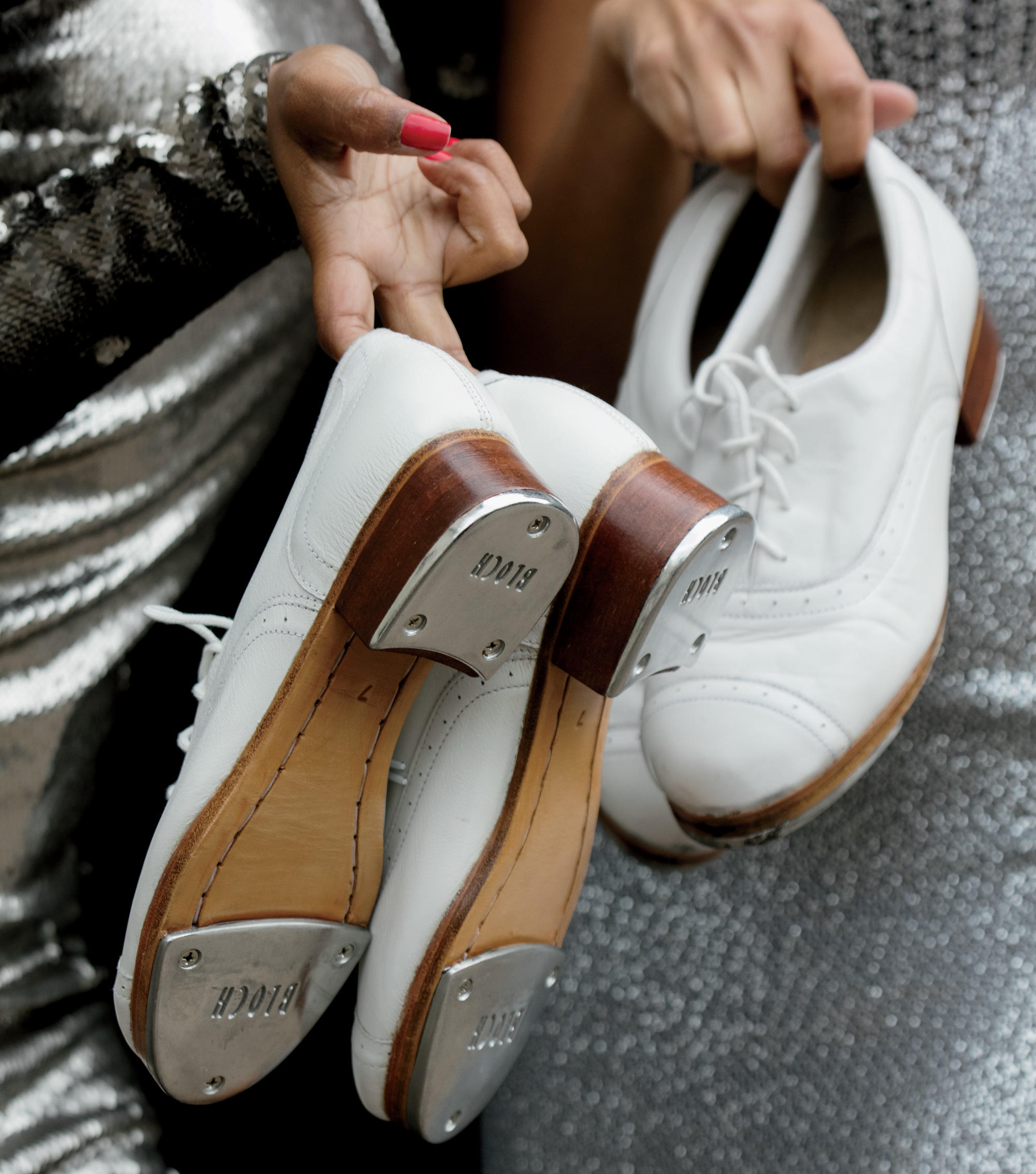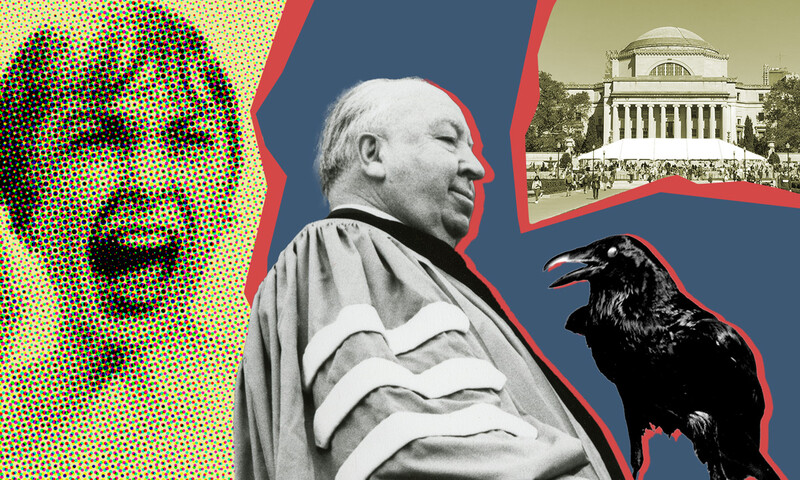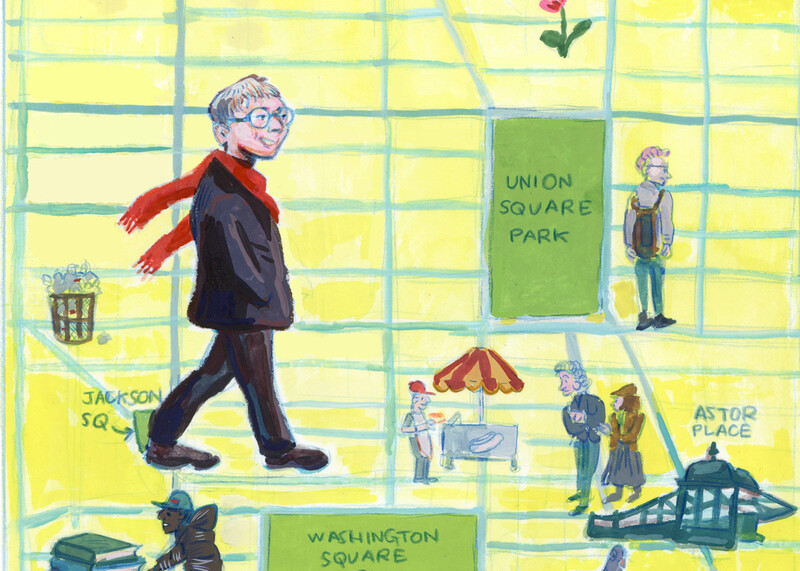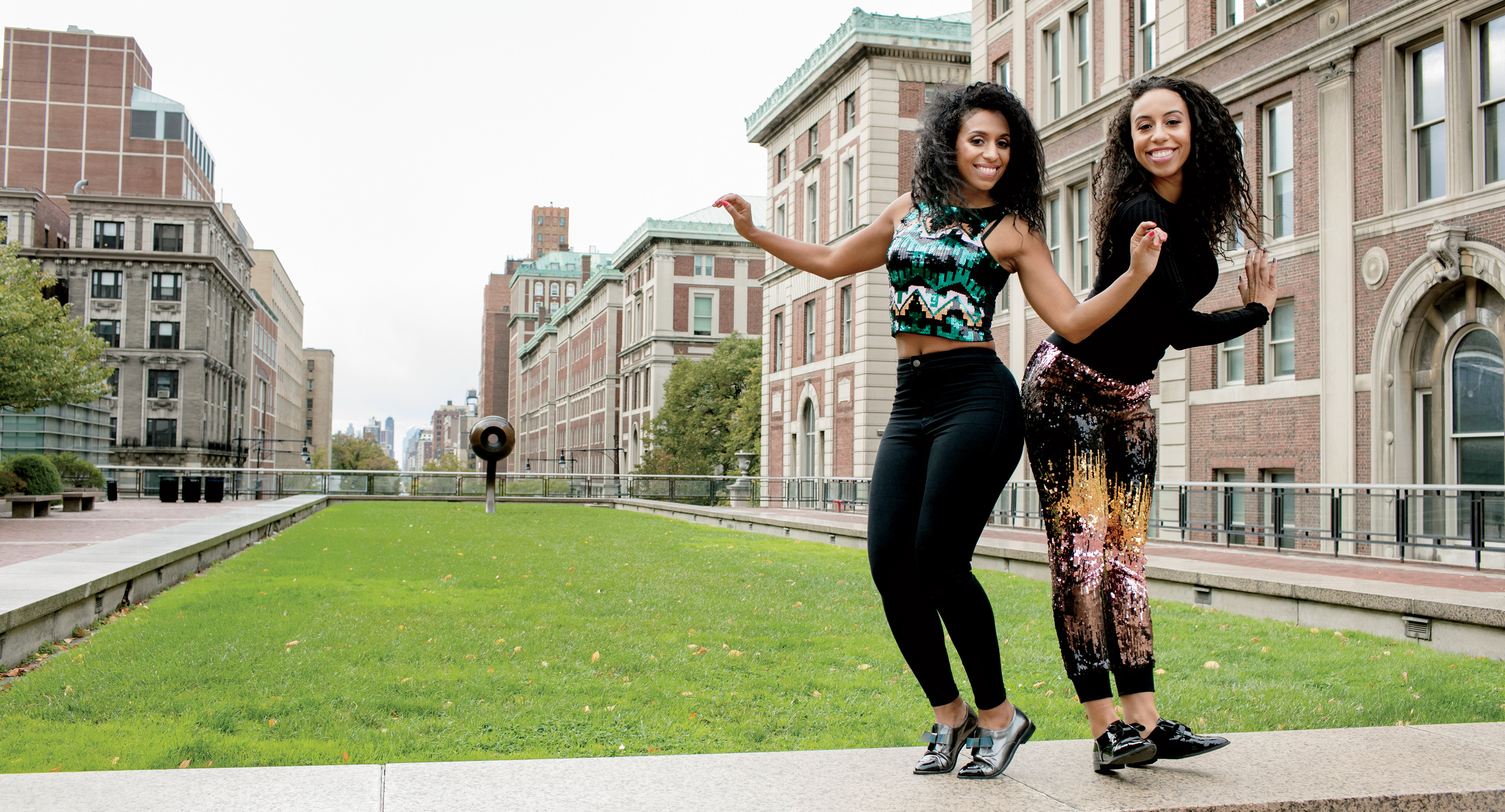
It’s five days before the show, and Chloe Arnold ’02CC is rehearsing her New York tap-dance troupe, Apartment 33, onstage at City College’s Aaron Davis Hall in Harlem. The dancers listen carefully as Chloe, wearing an Ivy Park hoodie and blue jeans, prepares them for the next number, set to Rihanna’s song “Work.”
“Do it with passion or not at all,” Chloe says, her voice firm and supportive. “You can never fake it, ever.” The dancers nod and get into formation.
The music starts, a mellow synth-pop groove, then crack! — the concussion of metal upon the floor, blunt force, and twelve bodies move as one, arms and legs and hips and hair, toes and heels banging out rhythms that vibrate the senses: sound as movement, sound made visible.
And now Maud Arnold ’08CC comes through the auditorium doors, carrying a white shopping bag. She’s been running around as usual. She’s a mover, a dealmaker, the social and business spark of Chloe & Maud Productions.
The dancers take a break, and Maud walks onto the stage and brings the bag over to Chloe.
“This is very exciting,” Chloe says, watching as Maud pulls a white shoebox from the bag. “We’re creating an affordable tap shoe for the nonprofessional. The shoes we wear cost hundreds of dollars.”
“These are in the seventy- or eighty-dollar range,” says Maud proudly.
“Maud and I wanted to create something for people who can’t afford top-of-the-line shoes but want to get into tap.”
“And that could be anyone.”
“From two to ninety-two,” says Chloe. “There was a guy who came to my class with a walker. You could be in a wheelchair. If there’s a way to create percussion with your feet, there are no limits to who can do it.”
No limits: that could be the sisters’ tagline. Tracing their arc from where they started to where they stand, they are the embodiment of Sly and the Family Stone’s “You Can Make It If You Try,” mixed with a little “We Are Family” by Sister Sledge. Like many of their peers, the sisters want to create change, but in their own fresh, offbeat way: through a traditional American art form that is perhaps more enjoyed than understood.
As Margo Jefferson ’71JRN, a Pulitzer Prize–winning cultural critic and Columbia School of the Arts writing professor, has observed, “Tap is a quintessential multipurpose form. It is dance, music, and theater, suitable for clubs, studios, street corners, chorus lines, and concert halls. It is aural, visual, and dramatic: it can tell a story about people, places, and emotions, or about rhythm, movement, and a body talking to no one but itself.”
Tap has its origins in Colonial times in the contact between enslaved Africans and Irish and English indentured servants. According to dance historian and tap dancer Margaret Morrison ’83BC, who teaches at Barnard, “The rhythmic imperative of African dance and drumming styles interacted with Irish and English clog dances. By 1900, all of that was fused.”
For many, the word “tap” evokes Fred Astaire or Bill “Bojangles” Robinson, minstrel shows or vaudeville — something, at any rate, anachronistic. But for Chloe and Maud, tap is as now as your own pulse.
“Tap has the ability to always stay current because of the choice of music,” Chloe explains. “In the 1980s, Gregory Hines danced to funk, and that’s what connected it to the people. When we tap-dance to the music I listen to, like Beyoncé and Rihanna and Prince, the public responds, because it’s what they’re listening to.”
In 1993, some of the greatest tap dancers in history gathered at the John F. Kennedy Center for the Performing Arts in Washington, DC, as part of Savion Glover’s DC Crew. The lineup included Gregory Hines, the nineteen-year-old prodigy Glover, and the fabled Nicholas Brothers. Also onstage was a twelve-year-old girl named Chloe Arnold.
That night, Chloe saw what it meant to be a professional tap dancer. She’d been dancing since she was six, and now she dreamed of someday leaving her own footprint on the field.
She lived in Washington with her kid sister, Maud, and their brother, Tadeo, who “always had our backs,” Chloe says. Their father, Eddie, was a Vietnam veteran and jazz connoisseur who worked in public relations. Their mother, Barbara, who was born in France, where her mother hid during the Holocaust, was a high-school teacher.
Around the time of the Kennedy Center show, Chloe took a bus trip to New York to see Jelly’s Last Jam, a Broadway musical about the jazz composer Jelly Roll Morton. The show starred Hines and Glover, with choreography by Hines and tap guru Ted Levy. The whole scene captivated Chloe. “When it’s my time, I’m going to live in New York,” she thought. “I’m going to college in New York.”
But things were tough at home. When Chloe was thirteen, Barbara moved the kids to a small apartment in northwest DC. “Our mom was the only white person in the neighborhood,” Maud says. Money was tight. Barbara took extra work as a waitress and translator. The sisters were inseparable. They shared a bedroom, and Chloe, now Maud’s babysitter, also became her dance teacher.
At fifteen, Chloe went back to New York to see the Glover vehicle Bring in ’da Noise, Bring in ’da Funk, a tap odyssey of African-American history. After the matinee, she wanted to check out Columbia. Some dancers from the show took her uptown. “I saw the campus and said, ‘This is going to be my life,’” Chloe says.
The next year, she got a part in a dance musical in DC directed by Debbie Allen, the dancer, singer, choreographer, director, and producer who played a tough-love dance teacher in the film and TV versions of Fame. Allen saw Chloe’s promise and became her mentor.
Meanwhile, at school, Chloe, Ivy-minded, signed up for everything: clubs, peer mediation, sports. She even got elected class president. Still, in her senior year, a teacher told her she would never get into Harvard. Chloe had no designs on Harvard, but the comment stung, and her smoldering mental response was Ohhh, you watch me. With the encouragement of Barbara and Tadeo (who would graduate from the University of Pennsylvania), Chloe applied to all the Ivy League schools.
“My mom was avid about our education and motivating us,” Chloe says. “She found this clip in a magazine that said, WHAT IF HARVARD WAS YOUR SAFETY SCHOOL? She cut it out and taped it to our door so that it was the first thing I saw each morning.” Chloe got into Harvard, and all the other Ivies. But her heart was set on Columbia.
Chloe applied for every scholarship available. The most substantial one she received was a Kluge Scholarship, a program endowed in 1987 by businessman John Kluge ’37CC, ’88HON, a German immigrant who had himself attended Columbia on grants.
At college, Chloe took classes from 9 a.m. to 2 p.m., and then at night she’d pack up her portable tap-dancing floor and go down to Greenwich Village for a jazz-club jam session. “Can I jump in?” she’d say, and she’d drop her board and ad-lib with the band. Tappers are percussionists, and to develop musicianship “you have to play with musicians,” Chloe says. Afterward, she’d go back to campus and do her schoolwork.
She majored in film and was singularly focused. “In college I always thought, ‘I’m going to put tap on film. Now, to make a film is insane, and even crazier is to become a professional tap dancer, and even crazier is to say, ‘I’m going to make tap movies.’ But in my head, that’s what was going to happen. Every film project I did was about tap. My thesis film was about tap. Everything was about tap.”
After graduation, Chloe moved to LA. She had no money, so Debbie Allen put her up and let Chloe shadow her at work. Allen told Chloe that if she wanted to tap professionally, she had to learn how to do it all: dance, direct, choreograph, write, and produce. Tap auditions were scarce, so you needed the skills to create the work itself.
One night in LA, at a tap jam session, Chloe ran into some other female dancers. She rarely saw other women at jam sessions. Sensing their power as a group, she pulled them together — along with the teenage Maud — and formed a dance crew called Syncopated Ladies, a wink to Sophisticated Ladies, the 1981 Broadway revue based on the music of Duke Ellington, starring Gregory Hines.
These Ladies were something different: young, gifted musician-dancers who, through their moves and outfits, asserted their femininity in ways seldom seen in tap — bare midriffs, ripped jeans, bustiers, a little leather, and a strong, athletic attack. Tap was about to graduate.
Maud, too, majored in film at Columbia, and by her senior year, a new rhythm was pounding across the land. Yes we can! Yes we can! Graduation speeches at Columbia in 2008 were filled with references to Barack Obama ’83CC, who was two weeks away from clinching the Democratic nomination for president.
Maud could relate to the candidate. They had a common educational experience, and they’d both had to settle the complexities of their mixed backgrounds.
“At Columbia, I met a lot of mixed kids who really weren’t sure who they were, and I was so sure about it,” Maud says. “I’m Black. My mom’s white, I love her, but I’m Black. Our dad taught us a lot about being proud to be Black. He always said, ‘The world will look at you as a Black person, so you have to recognize that. You’re not better than anybody because you’re light-skinned.’ I’m so grateful, because it saved me a lot of time and emotion questioning this.”
Obama won the election, and Maud and Chloe were in the crowd outside the Capitol on Inauguration Day. “It was cold, but we didn’t care,” says Maud. “It was one of the greatest days of my life.”
With Maud out of school, the sisters started Chloe Maud Productions. Mindful of Debbie Allen’s gospel of versatility, they performed with Syncopated Ladies and also pursued jobs as production assistants on music-video shoots. Among the artists they got to work for was one of their heroes: Beyoncé.
“Beyoncé made me see the role of women in entertainment differently,” Chloe says. “She’s so unapologetically amazing, and at the same time, she lifts everybody up and makes you feel amazing. It doesn’t matter if you’re picking up trash — you still feel like you’re part of the most incredible production ever. I thought, ‘That’s what I want for Syncopated Ladies. I want these women to feel that we are lifting each other up.’”
By 2013, the sisters were ready for a new step. “Maud,” Chloe said, “it’s time to use our film degrees. Let’s make music videos of tap dancing.”
Chloe choreographed a piece for Syncopated Ladies, set to Rihanna’s “Where Have You Been.” Dark stage, floor lights, black shorts and bodices, silver glitter, studded boots, rapid-fire syncopations, kinetic camera work. Chloe and Maud put the polished product on YouTube, and it quickly got more than sixty thousand views. “I was blown away,” Chloe says. “I had no idea that we could get tap seen by that many people.”
Next, as an expression of gratitude to Beyoncé, the Ladies made a video to her song “End of Time.” To their surprise, Beyoncé shared it on Facebook. Within days that video got more than five hundred thousand views. The popular TV show So You Think You Can Dance took notice, and the Ladies were invited to compete in the show’s first-ever dance-crew battle. They won.
Twitter was aflutter. Blogs and magazines swooped in. People started recognizing Chloe and Maud on planes. Now the question had new urgency: what next?
If there is a glass ceiling for women in tap, it’s full of cracks made by generations of rapping feet. For Chloe, tap history is filled with women who “did the work but don’t get the credit they deserve,” and she recalls the lack of prospects that she faced coming up.
“I was really entering a boys’ club,” she says. “You had Tap Dogs and Bring in ’da Noise, Bring in ’da Funk; there were no roles I could get into.” Nor was Riverdance an option. “If you look at Broadway, there are very few shows that feature or star a Black woman, and very few African-American producers and choreographers,” says Chloe. “I would say to myself, ‘If it doesn’t exist, create it.’”
In the critical realm, too, she encountered a certain narrowness of perspective. “Some people didn’t like that I was using my curves, my African-American culture, incorporating African dance and hip-hop and things that are authentic to my experience,” she says. “There was a lot of resistance, and Debbie Allen was so pivotal in saying, ‘Ignore them, go forward, don’t let them stop you.’”
Margaret Morrison, who knew Chloe and Maud at Columbia and had Maud as a student, notes that the Arnold sisters are fighting against centuries of ideas. “Anything too close to sexuality and the female body is considered less art-worthy, less rigorous, less serious. It’s entertainment, not art. Chloe just dives into that and says, ‘That’s BS. Who made these rules?’ And that’s how I feel. It’s the twenty-first century! We’ve been through postmodernism! Who made these rules?
“Some women of my generation felt it was important to downplay sexuality to align ourselves with art, so we did that,” says Morrison. “Then Chloe’s generation came along and said, ‘That’s interesting, but why?’ We fought that fight, and Chloe doesn’t need to fight it anymore. Now she and Maud can fight a different battle.”
On February 6, 2016, Beyoncé released “Formation,” an empowerment anthem of Black womanhood whose music video contains visual references to police violence and the abandonment of African-Americans in Hurricane Katrina. The next day, the singer performed “Formation” during the halftime show of Super Bowl 50.
If Chloe and Maud weren’t sure what to do next, now they knew. Chloe created a dance for “Formation,” and the Ladies hit the studio. “The idea of formation — of getting people unified — inspired me to reach out to people in countries I’d traveled to as a performer,” says Chloe. “I sent them instructions for the dance and told them that if they could learn this and film it in a week, they might be in our video.” The response was emphatic: the video features dancers from Chicago, DC, Seattle, LA, Taipei, Rio de Janeiro, and more.
The sisters uploaded the video, not expecting Beyoncé herself to see it. Not only did she see it — she posted it on her homepage. In two weeks it got eight million views, and now it has more than thirteen million.
Beyoncé hired the Ladies to perform in London at the launch of her clothing line, Ivy Park, in April. A week later, the pop star Prince, another major influence on Chloe and Maud, died unexpectedly. Syncopated Ladies made a tribute video, set to “When Doves Cry.” That one has topped twenty-five million views.
Says Morrison, “Probably more people have seen tap dance through the ‘Formation’ and Prince videos than anything since the Hollywood era of the 1940s and ’50s. That in itself is astounding.”
Calls poured in. Chloe got hired as a choreographer on So You Think You Can Dance and The Late Late Show with James Corden. In July, Syncopated Ladies performed in Philadelphia at the Democratic National Convention. And now, in the fall, Chloe and Maud were ready to roll with Apartment 33.
While Chloe creates dances and runs rehearsals, Maud meets people and closes deals. The Chloe & Maud portfolio now includes the two bicoastal tap troupes; the DC Tap Festival (started in 2009 and expected to draw, in April, six hundred dancers from around the world); an afterschool program in LA called Tap Into Life (“We want to provide education and scholarships for inner-city kids,” says Chloe. “We were once those kids, and we had mentors and got scholarships from Columbia — so we are very heavy on scholarships”); and the buoyant 2015 documentary Tap World, which showcases modern tap virtuosos and demonstrates the community-building potential of the form.
Next, the sisters want to create a TV documentary series about their lives as tap dancers and entrepreneurs, and build franchised shows for Syncopated Ladies and Apartment 33 so that they can do their favorite thing: hire dancers, especially women dancers.
“Women have been marginalized in tap,” says Chloe. “We have dancers around the world aspiring to work with us, so our responsibility is to create work. We’re trying to create an industry.”
It’s showtime at Aaron Davis Hall. Apt. 33: Where Dreams Are Made is based on the stories of tap dancers in New York who have used Chloe and Maud’s real-life Washington Heights apartment (unit 33) as their communal crib. Choreographed by Chloe, the show projects Fame-era wholesomeness juxtaposed with present-day issues, as if the graffiti-covered New York of 1980 — the auditions and rehearsals and blue Greek-diner coffee cups — had fused with Black Lives Matter and an affordable-housing shortage.
Like many artists, the sisters are anguished by the unending incidents of police violence against African-Americans. They know plenty of people with stories, and have had their own disturbing run-ins. They wanted to say something in the show, to present a united front against what Maud calls “blind hatred,” a solidarity underscored by the diversity of the dancers, who come from India, Australia, Honduras, Montana, Brazil. “We can’t push forward unless we’re a collective,” says Chloe. “It can’t just be African-Americans fighting for our rights; it has to be everybody saying these are human rights.”
Onstage, video images pulsed behind the dancers on a large screen. Midway through the show, an ensemble performed a piece called “One Day . . .,” set to the ballad “Glory,” by Common and John Legend, from the movie Selma. As cell-phone footage of police violence played onscreen — of bodies lying unattended, of grief and terror and outrage — the lead dancer, Gerson Lanza, stomped ecstatically, mournfully, transmuting the dynamics of a national emergency into furious rhythm; and as the screen flashed with clips of civil-rights protests past and present, the dancers nailed the insistent steps, and ended with their fists raised in unity and defiance.
There was a soundless shiver. And then, one after another, the people stood. They clapped, whistled, called out, cried out. The air trembled. Tap had spoken.

